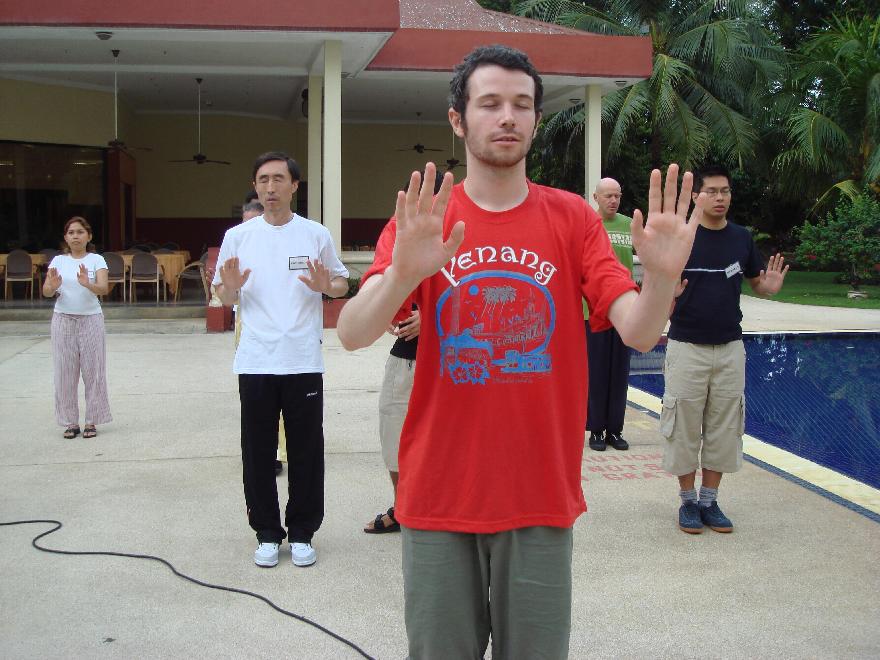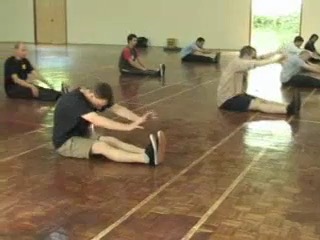EFFECTS OF CHI KUNG PRACTICE

Pushing Mountain
Question
Following the programme laid out in your books, “Chi Kung for health and Vitality” and “the Art of Chi Kung”, I practice the sets as recommended for a person doing martial arts, i.e. with emphasis on “Pushing Mountains” and “Big Windmill”. Here are some effects I have noticed after one month's training with one session a day for approximately half an hour.
In “Big Windmill”, my hands are heavy and I feel the “heaviness” move from my wrist to my palm and fingers. I experience side to side swaying while practising induced chi flow. This has also happened spontaneously while in standing meditation recently. I noticed I was beginning to sway, then I just forgot about it and “let go”.
Even though the swaying is sometimes quite energetic, my feet feel quite “rooted” to the ground, and although I have my eyes closed I am not afraid I will fall. Afterwards when I open my eyes (after I have told myself to stop) I see my surroundings as if new, more detailed, and more colourful. It's a good feeling of well-being and I thank you for the excellent way the techniques are presented in the books.
-- Kevin, Finland
Answer
Congratulations Kevin, you have done extremely well, especially that you only learned from my books and have not previously learnt from me in person..
“Pushing Mountains” and “Big Windmill” are two powerful exercises but they are relatively safe if one follows the instructions respectfully. This makes them quite special. Powerful exercises are usually unsafe to be performed without a master's supervision; “Pushing Mountains” and “Big Windmill” are therefore exceptions. As a comparison, “Golden Bridge” and “Three-Circle Stance” — two of the most famous zhan zhuang exercises — are also powerful, but although they look simple, they are likely to bring adverse side-effects to someone practising on his own.
Feeling of “heaviness” at your palms is a normal result of practising “Big Windmill” correctly; it is an indication of your having developed internal force. It is your great achievement that you can experience internal force in one month when many external martial art masters have chased after it to no avail for years, and when some think that internal force is a myth.
Your internal force is the result of energy flowing from your dan tian through your shoulders, through your elbows, and through your wrists to your fingers. In kungfu terminology this is referred to as “king thow ng kwan” (Cantonese pronunciation), which means “internal force going through five hurdles”. The “five hurdles” — which may also be translated as “five gates” — are the dan tian, the shoulders, the elbows, the wrists and the palms or fingers. They are regarded as “hurdles” because in an untrained person, energy flow is often locked at these places. Many external martial artists, for example, lock their energy at their shoulders or elbows.
As you progress, you may later feel as if the heaviness at your palms has disappeared. This may make you wonder whether you are getting any benefits from your training, or whether your energy has drained away from your fingers. The fact is that you still continue to develop internal force but you do not feel the heaviness even your internal force is stronger because you are now more used to the sensation of internal force. Secondly, your energy has not drained away, but some of it has flowed into your body for more important tasks, like maintaining life and enhancing both your physical as well as mental functioning.
The side to side swaying during induced chi flow is due to energy concentrating at your arms and palms. Letting go to allow your chi to flow wherever it wants, is the right thing to do. This is known as “wu-wei” (Mandarin pronunciation) in Taoist philosophy. “Wu-wei” is often translated as “non-action”, which can be misleading. A better translation is “spontaneity”.
Being rooted to the ground while your body and hands may be swaying vigorously, is a manifestation of an important skill in Shaolin Kungfu known as “yew foong pai lau” (Cantonese pronunciation), which may be expressed as “a sturdy tree swaying in the breeze”. This skill enables you to be very fast and agile while solid and powerful at the same time.
Induced chi flow is both a cleansing and a strengthening process, and it involves both your physical and spiritual being. As a result you see things and relationships more beautiful. The external world and other people have not changed, but you have. You have undergone a spiritual purification and strengthening. As your spirit is stronger, you become more confident; as your spirit is purer, you find the world more beautiful. These are some of the wonderful benefits in Shaolin training not found in most other martial arts.
Question
I would like to ask Sifu some questions if I may: In order to relax my abdomen as much as possible and improve abdominal breathing, I cut out training sit-ups from my training routine. This has had the effect that I have a rounded belly. Is such an exercise detrimental to muscle relaxation? I do not train with weights, but I normally do sit-ups and push-ups to keep in shape. Also, to maintain aerobic fitness, I usually jog for 30-50 minutes every second day. So, are such exercises diametrically opposed to chi kung training?
Answer
Chi kung training gives us the best weight and shape, but the point of reference is life performance and not cultural taste. A rounded belly, which functions excellently as an energy bank, enables you to perform life activities effectively. Gradually your arms and legs will also be smooth and rounded, instead of muscular. Muscular arms and legs are actually detrimental to work efficiency because much energy which could be used for doing work is locked up in the muscles, and the muscular mass slows down speed. Rounded arms and legs promotes energy flow, which enhances both internal force and speed.
Eastern and Western societies have different cultural taste. Rounded belly is considered healthy and beautiful for both men and women in the East (but young Eastern men trained in Western culture may think otherwise), whereas Western societies prefer flat belly, especially for women. As a person's vital energy is stored in his abdominal dan tian, a person with a flat belly is considered lacking in vitality. If you observe kungfu masters, you will notice that they have rounded bellies. In traditional Eastern societies, when a mother chose a wife for his son, she would not want her future daughter-in-law with a flat belly, for it would signify that she lacked not only vitality but also “later-life prosperity”.
From the chi kung perspective, sit-ups and push-ups when performed as physical exercise are detrimental to relaxation because they build up tough muscles, and therefore detrimental to speed and application of internal force. Nevertheless, the adverse effects can be neutralized if they are performed as chi kung exercises. For example, in Shaolin Kungfu the leg stretching exercise called “Immortal Takes Off Shoes” is similar to sit-ups, and the arm-strengthening exercise called “Taming Tigers” is similar to push-ups.
They are performed as chi kung exercises as follows. In “Immortal Takes Off Shoes”, breathe out through the mouth as you bend forward to touch your toes, and breathe in through the nose as you sit upright. In “Taming Tigers”, breathe in through your nose as you bend your arms to lower your body to the ground, and breathe out through your mouth as you straighten your arms to raise you body. Both exercises must be performed in a relaxed manner, without the use of muscular strength.
From the chi kung perspective, jogging is bad for health! It overworks internal organs, bounces them about inside the body, and the constant jabbing of the feet onto the ground sends shock waves to the internal organs. There is a Shaolin art called “Thousand Steps” which looks like, but is not jogging. Here the practitioner controls his breathing in various ways in running to train speed and stamina.
I would suggest that you drop sit-ups, push-ups and jogging in your training programme. You can achieve what these exercises provide, like developing force, speed and stamina, more effectively and without their adverse effects by practising “Pushing Mountains”, “Big Windmill” and other chi kung exercises.

Immortals Take off Shoes
The above is taken from Questions 9 and 10 Jun 2002 Part 3 of the Selection of Questions and Answers.
LINKS
Courses and Classes
